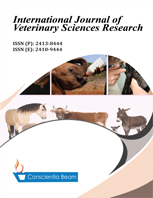Porcine parasitic zoonosis in the Ashanti region of Ghana
DOI:
https://doi.org/10.18488/ijvsr.v8i2.3489Abstract
Pigs are coprophagous omnivores that feed on a wide range of food, thus making them susceptible to parasitic infections. This study aimed to examine the prevalence and diversity of gastrointestinal parasitic infections among pigs in the Ashanti Region of Ghana, kept under different management systems. A total of 400 fresh fecal samples from pigs of varying ages and sex were collected and analyzed using standard coproscopical techniques. Questionnaire interviews were used to assess management practices on the pig farms. The associations between age, breed, sex, and management systems and the prevalence of parasites were determined. The overall prevalence of gastrointestinal parasites in pigs was 88.75%, with multiple infections being more common than single infections (p < 0.05). Overall, thirteen (13) genera of protozoa and helminths were recovered from the pigs, including parasites of zoonotic importance to man. Eimeria spp. had the highest prevalence (64.5%), while the least prevalence (0.25%) was recorded for Balantidium coli and Isospora spp. Age, breed, sex, and type of management systems were not significantly associated with infections in pigs. The lack of treatment of pigs creates ideal conditions for the spread of zoonotic infections in the region.

